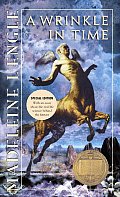
| Series: | Time #1 |
| Publisher: | Dell |
| Copyright: | 1962 |
| Printing: | September 1997 |
| ISBN: | 0-440-99805-0 |
| Format: | Mass market |
| Pages: | 198 |
In the mood for someting light and quick to read, I decided to re-read A Wrinkle in Time, a book I'd read once before but quite some time ago. L'Engle's time quartet (or quintet) are part of fond childhood memories for many readers, but I'd only read the first and only as an adult. That's worth bearing in mind while reading my reactions. L'Engle has an appeal that I'm not sure is fully appreciated by the adult reader.
L'Engle isn't going far outside the formula for children's books here, but she does the standard formula with a great deal of charm and unique style. Meg is a typical child hero with low self-esteem, not many friends, and a quirky family. She ends up on a grand cosmic mission travelling to another planet to search for her father and fight the forces of evil, but L'Engle takes plenty of time for characterization. It's not that deep or surprising (except for Meg's wonderfully precocious younger brother, Charles Wallace), but one comes away with a fond feeling towards Meg's family and her friend Calvin and the feeling that they're real people (if horribly loving and honest and good) with real worries.
The best part of the book is Charles Wallace, Meg's five-year-old brother with the vocabulary of an adult and the understanding of a teenager, and the trio of Mrs. Whatsit, Mrs. Who, and Mrs. Which. L'Engle's quirky cosmic guides are a delight, some of the better mentor-figures of this type I've seen. The first section of the book is a great build-up of suspense and wonder from a prosaic beginning. Unfortunately, the last half isn't as good, certainly not up to the standards of the opening, and had been forgettable enough to drop out of my memory.
First, I just didn't buy L'Engle's bad guys. This is aimed at a young enough audience that I can excuse clear-cut good and evil distinctions with no subtlety, but even with that allowance, the nature of evil didn't work for me. The story sets up a tempting evil that fails to be tempting beyond lip service and appears unable to muster any resources beyond raw power. Meg is never in the slightest danger of believing anything the evil tells her. Evil as excessively strict rules and destruction of originality isn't a bad motif, but the evil world comes across as a watered-down version of 1984 without any logical background or depth. Combine that with a villain taken oddly from Lewis's That Hideous Strength and a resolution that one can see coming a mile off and I found myself wanting more subtlety even in a children's book.
A Wrinkle in Time also felt surprisingly derivative. That's something children won't care about, but reading it as an adult, I kept seeing bits that C.S. Lewis had done before and done better. I like Lewis's stars from Narnia better, the galactic war against the darkness felt like it was taken straight from the Space Trilogy, and I've already mentioned the disembodied brain. L'Engle also seemed to take some elements that didn't fit the nature of her story: Lewis's disembodied brain is a symbol of logic and rationalism run amok, used to crush a wilder, natural, mystical epiphany that is the force of good in the Space Trilogy. L'Engle's story, on the other hand, takes a more conventional view of technology as a force without inherent morality, with scientists and inventions playing a major role on both sides. In that context, the disembodied brain loses all its symbolic role and is just a disgusting image with no real thematic purpose. Again, not something that a child reader may care about, but I found it annoying.
Finally, while the first part of the book stumbled only a few times, the second half felt didactic and preachy. I find it amusing that people accuse C.S. Lewis of being too religious and A Wrinkle in Time has been banned by some schools (probably because it refers to the true age of the universe), since L'Engle is far preachier than Lewis. At times, her characters even start quoting scripture at each other, usually a hallmark of far worse books than this. It's a testament to the charm of L'Engle's storytelling that this doesn't entirely ruin the book, but I could have done with more action and fewer extended explanations, Socratic dialogs, and obvious moral lessons.
A Wrinkle in Time still a good children's book; it does has that elusive charm. But it verges on being pointedly religious enough to annoy (there's only some specifically Christian preaching, but there's a lot of good-versus-evil fighting and clear spiritual war), and it didn't hold up to an adult re-reading as well as I was hoping.
Followed by A Wind in the Door.
Reviewed: 2006-02-22